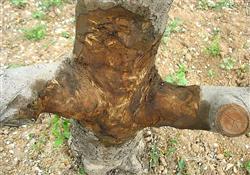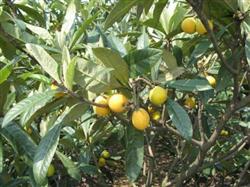What diseases and insect pests need to be controlled in planting loquat?

What diseases and insect pests need to be controlled in planting loquat? Please give an introduction and control methods to plant loquat diseases and insect pests are as follows: 1. There are many reasons for loquat ear rot caused by flower ear rot, but it is mainly caused by pests and climate. During the flowering period of loquat (September-November), the continuous autumn rain and high humidity accelerated the occurrence of flower ear rot. Especially in the middle and late anthesis, the flower axis becomes brown and soft rot is rotten, and there will be viscous fluid flow out of the diseased part by hand, and the flower axis will shrink and wither in the later stage. 2. According to the preliminary investigation of leaf and fruit diseases, the diseases that harm leaves and fruits are: Brown spot, leaf spot, dirty leaf disease, wheel spot, gray spot and anthracnose, black rot, brown rot, sunburn and so on. These diseases are harmful to young leaves of new shoots and old leaves, and some of them can also harm flowers, spikes, young fruits and so on. After the young leaves were killed, they curled and withered, affecting the new shoots; after the old leaves were killed, they caused a large number of fallen leaves; after the fruit was killed, brown round disease spots were formed at first, which expanded rapidly around the navel of the fruit, and finally rotted to eat, losing commercial value. It has a great impact on the yield. 3. The main harmful mites of loquat leaves, tender shoots and flowers are nymphal mites. The generations of this mite occur ominously every year in loquat producing areas, but the generations overlap, which will seriously affect the flower bud differentiation of loquat. When the flower is killed, it wilts and forms a soot, causing a large number of spikes to fall off. 4. Loquat yellow caterpillar is the main pest of loquat. It eats tender leaves and buds with larvae. When serious, even old leaves are eaten into only veins, and even loquat trees die. This insect occurs and does harm in May-October. But the damage is the most serious from August to September. 5. The adults and nymphs of the planthopper feed on the new shoots, petioles and leaves. The veins of the injured leaves were twisted, the leaf surface shrunk, withered spots were produced, and gradually blackened, resulting in coal fouling and defoliation. 6. The heart borer harmful to loquat are pear heart borer and peach borer, mainly pear heart borer. Pear heart borer has mixed feeding habits. Larvae eat loquat shoots and cause wilting, spike rachis and flower ear rot, fruit decay. The following methods can be used to control diseases and insect pests in planting loquat: 1. Improving the resistance of loquat trees to diseases and insect pests is the basic measure to control the harm of diseases and insect pests. Strengthen orchard management, cut off dense branches, bare-legged branches, thinning, retraction and short pruning after fruit harvest, especially cut off the branches of diseases and insect pests, depress the growth of vigorous branches and make them grow slowly, so as to promote the emergence of summer shoots and lay the foundation for high yield in the next year. Control nitrogen fertilizer, increase phosphorus and potassium fertilizer, so that prosperous trees do not apply nitrogen fertilizer; do a good job of drainage and irrigation system so that it can be drained in rainy season and irrigated in drought, and young tree gardens generally do not irrigate from July to August, and loosen the tree disk in time. Through these agronomic measures, the stress resistance of loquat trees can be enhanced and the damage of diseases and insect pests can be reduced. 2. timely spraying protection to control the harm of diseases and insect pests under the economic allowable level, according to the annual growth phenological period of loquat and the corresponding occurrence characteristics of diseases and insect pests, grasp three key application times: first, each shoot stage of loquat (spring, summer and autumn). The diseases and insect pests in this period are leaf diseases (gray spot, brown spot, leaf spot, ring spot and anthracnose, etc.), and the main pests are yellow caterpillar, pear heart borer and wood lice. Fungicides and insecticides can be mixed; 43% Dasheng 600 Mel 800 times plus 40% Ju Lei 1000 Mel 1200 times, or 43% Dasheng Fu 600 Mel 800 times plus 20% good winter 1000 times or 4.5% Green Pepsi 1000 Mel 1500 times; the second is florescence. This period is also the autumn shoot emergence period, coupled with the continuous autumn rain, there are many kinds of diseases and insect pests, including flower rot, wood lice, nymph mites, pear heart borer, peach borer and so on. It can be used to control flower rot with 2.5% Uranus 1500 times or 73% fruit orchards with 3000 times, 43% Dasheng rich 600 times or 25% leaf spots 4000 times spray to control leaf spot, anthracnose, etc., 40% giant thunder 1000 100 times or 10% an Lubao 1500 times to control wood lice, pear heart borer, peach borer, etc.; the third is the fruiting period. Whether the damage of diseases and insect pests can be controlled in this period is the key to the yield increase of loquat. The main diseases in this period are anthracnose, brown rot and black rot, and the main pests are pear heart borer, peach borer, bugs, scale insects and so on. Drugs are used at the same time (so as not to repeat them). Once flax spot disease is found in the young tree garden and nursery, it should be pulled out immediately. For orchards where dry rot occurs, the disease department should be scraped off immediately and brushed with 2% plus 100 times of rice. When white and purple feathers are harmful to the neck of loquat, 71% Aili is used to kill 800x or 30% Aijiao 3000 times to irrigate around the root. Click to get more loquat planting techniques click to get more fruit planting techniques
- Prev

How to prevent and cure apple rot in summer?
How to prevent and cure apple rot in summer? Please introduce the methods for the prevention and control of apple tree rot. For many years, attention has been paid to the prevention and control of apple tree rot in spring, ignoring the prevention and control in summer and autumn, resulting in a high recurrence rate of the disease and can not be completely cured. However, according to the incidence law of the rot disease, the first curettage in spring was changed to summer and autumn, combined with spring control.
- Next

What is the management of loquat trees in summer?
What is the management of loquat trees in summer? Please give guidance on summer loquat tree management as follows: 1. Dredging ditches: loquat roots are shallow and stagnant water is avoided. After continuous rainfall in the previous period, ditches should be drained smoothly in time. 2, fertilization: should be carried out within 10 days before harvest, the amount of fertilizer application accounts for.
Related
- Moge, come on! The staff of the peasant association in the producing area of cantaloupe were frightened when the crowd gathered.
- Causes and Solutions of low Fruit setting rate of Apple
- Symptoms and control measures of passion fruit virus disease
- Fruit growing lesson: how do apple orchards keep high yields?
- Can you build orchards in the mountains? What are the pros and cons?
- How to manage the coloring period of Crisson grape?
- This paper introduces the processing technology of two kinds of fig products.
- How much is a month for retired teachers in rural areas by 2020?
- How can strawberry planting increase sugar content? We should pay attention to management in many aspects.
- What are the cultivation techniques on how to improve the yield of golden fruit?

